Understanding the Job Mobility and Employability of Older Workers
Understanding the Job Mobility and Employability of Older Workers
Understanding the Job Mobility and Employability of Older Workers
Create successful ePaper yourself
Turn your PDF publications into a flip-book with our unique Google optimized e-Paper software.
WORKFORCE 2020<br />
AGEING WORKFORCE<br />
<strong>Underst<strong>and</strong>ing</strong> <strong>the</strong> <strong>Job</strong><br />
<strong>Mobility</strong> <strong>and</strong> <strong>Employability</strong><br />
<strong>of</strong> <strong>Older</strong> <strong>Workers</strong>
ACKNOWLEDGEMENT<br />
Department <strong>of</strong> Labour<br />
Disclaimer: The Department <strong>of</strong> Labour has made every effort to ensure that <strong>the</strong><br />
information contained in this report is reliable, but makes no guarantee <strong>of</strong> its<br />
accuracy or completeness <strong>and</strong> does not accept any liability for any errors. The<br />
Department may change <strong>the</strong> contents <strong>of</strong> this report at any time without notice.<br />
ISBN: 978-0-478-33352-7<br />
© Crown copyright 2009<br />
This material is Crown copyright unless o<strong>the</strong>rwise stated <strong>and</strong> may be reproduced<br />
free <strong>of</strong> charge without requiring specific permission. This is subject to it being<br />
reproduced accurately <strong>and</strong> not being used in a derogatory manner or in a<br />
misleading context. The source <strong>and</strong> copyright status should be acknowledged.<br />
The permission to reproduce Crown copyright protected material does not extend<br />
to any material in this report that is identified as being <strong>the</strong> copyright <strong>of</strong> a third<br />
party.<br />
Department <strong>of</strong> Labour<br />
PO Box 3705<br />
Wellington<br />
New Zeal<strong>and</strong><br />
www.dol.govt.nz<br />
For Department <strong>of</strong> Labour research,<br />
visit www.dol.govt.nz/browse-dol.asp<br />
For <strong>the</strong> Workforce 2020 web page, visit<br />
www.dol.govt.nz/services/LMI/workforce2020/index.asp<br />
2
CONTENTS<br />
LIST OF FIGURES......................................................................................4<br />
SUMMARY OF KEY POINTS........................................................................5<br />
1. PURPOSE ..............................................................................................6<br />
2. BACKGROUND.......................................................................................7<br />
3. METHODOLOGIES .................................................................................8<br />
4. OLDER WORKERS’ INCREASING IMPORTANCE IN THE LABOUR FORCE.9<br />
5. OLDER WORKERS IN THE RECESSION.................................................11<br />
6. COMPLEXITIES FACED BY OLDER WORKERS MOVING IN OR OUT OF<br />
WORK – SOME KEY FINDINGS ............................................................12<br />
6.1 Specialised skill <strong>and</strong> knowledge (human capital) .................................. 12<br />
6.2 Forms <strong>of</strong> employer discrimination....................................................... 13<br />
6.3 Firms’ reward systems <strong>and</strong> individual wage expectations ...................... 14<br />
6.4 Difficulties in training <strong>and</strong> upskilling ................................................... 15<br />
6.5 Lower formal education qualifications <strong>and</strong> job signalling........................ 16<br />
6.6 A preference for work over retraining ................................................. 16<br />
7. MOVING FORWARD.............................................................................18<br />
7.1 Supporting older workers through <strong>the</strong> recession <strong>and</strong> beyond ................. 18<br />
7.2 Next Steps ...................................................................................... 19<br />
3
LIST OF FIGURES<br />
Figure 1: Projected New Zeal<strong>and</strong> labour force by age group, 2006–2050 ............9<br />
4
SUMMARY OF KEY POINTS<br />
<strong>Older</strong> workers (aged 55+) are increasingly important in <strong>the</strong> New Zeal<strong>and</strong> labour<br />
market both in numbers <strong>and</strong> in terms <strong>of</strong> <strong>the</strong>ir skills <strong>and</strong> knowledge. They now<br />
comprise one sixth <strong>of</strong> <strong>the</strong> New Zeal<strong>and</strong> labour force <strong>and</strong> are expected to<br />
represent nearly one in four <strong>of</strong> <strong>the</strong> workforce by 2020.<br />
Collectively, older workers are productive <strong>and</strong> valued, but <strong>the</strong>ir knowledge may<br />
be specific to <strong>the</strong>ir current jobs. This may hinder <strong>the</strong>ir job mobility, making it<br />
difficult for <strong>the</strong>m to change jobs <strong>and</strong> transfer <strong>the</strong>ir skills to o<strong>the</strong>r work areas.<br />
<strong>Older</strong> workers have experienced good employment <strong>and</strong> pay levels over <strong>the</strong> past<br />
few years. However, because <strong>of</strong> <strong>the</strong> specialised nature <strong>of</strong> <strong>the</strong>ir skills <strong>and</strong><br />
knowledge, <strong>the</strong> current downturn presents challenges to mature-aged workers.<br />
Due to <strong>the</strong>ir skills being harder to transfer, older workers are more at risk <strong>of</strong><br />
being long-term unemployed or <strong>of</strong> leaving <strong>the</strong> job market altoge<strong>the</strong>r if <strong>the</strong>y lose<br />
<strong>the</strong>ir jobs.<br />
Increased unemployment, early exit from <strong>the</strong> labour force <strong>and</strong> poor job matches<br />
among this group will weaken <strong>the</strong> strength <strong>of</strong> an economic recovery in future. It<br />
will also impose increasing economic costs in <strong>the</strong> longer term as <strong>the</strong> supply <strong>of</strong><br />
newer, younger workers tapers <strong>of</strong>f.<br />
There is increasing value in ongoing training for older workers as working lives<br />
leng<strong>the</strong>n, <strong>and</strong> as <strong>the</strong> dem<strong>and</strong> for constantly updated skills grows. However, <strong>the</strong>re<br />
are some barriers to training that need to be overcome.<br />
To promote discussion, <strong>the</strong> final section <strong>of</strong> this paper considers what may help <strong>the</strong><br />
job mobility <strong>of</strong> older workers in a changing job market, including:<br />
• adapting employment, training <strong>and</strong> careers services<br />
• promoting positive messages<br />
• identifying information about capabilities <strong>and</strong> transferable skills<br />
5
1. PURPOSE<br />
This report provides information <strong>and</strong> an evidence base to help prepare<br />
New Zeal<strong>and</strong> for <strong>the</strong> labour market challenges <strong>and</strong> opportunities presented by an<br />
older workforce (defined in this study as people aged 55 plus).<br />
<strong>Older</strong> workers currently comprise one sixth <strong>of</strong> <strong>the</strong> New Zeal<strong>and</strong> labour force <strong>and</strong><br />
are expected to represent nearly one in four <strong>of</strong> <strong>the</strong> workforce by 2020.<br />
We focus on issues associated with <strong>the</strong> ability <strong>of</strong> older workers to move between<br />
jobs, especially in an environment where jobs may be at risk.<br />
Our aim is to start a discussion about what older workers, employers <strong>and</strong><br />
government could do to support <strong>the</strong> employability <strong>of</strong> older workers in <strong>the</strong> current<br />
downturn <strong>and</strong> subsequent recovery.<br />
6
2. BACKGROUND<br />
Population ageing in New Zeal<strong>and</strong> is a key driver <strong>of</strong> change in <strong>the</strong> labour market.<br />
Industries <strong>and</strong> employers need to fully harness <strong>the</strong> skills <strong>of</strong> <strong>the</strong> older workforce to<br />
maintain productivity levels <strong>and</strong> performance as <strong>the</strong> worker pr<strong>of</strong>ile changes.<br />
Proactive responses to workforce ageing at a firm <strong>and</strong> industry level are needed<br />
to create <strong>and</strong> enhance overall economic growth. For example, employers will<br />
increasingly need to consider employing older workers for a wide range <strong>of</strong> jobs<br />
traditionally associated with younger workers.<br />
For <strong>the</strong>ir part, older job seekers need to consider ways to adapt <strong>and</strong> harness <strong>the</strong>ir<br />
valuable store <strong>of</strong> skills for jobs in areas where <strong>the</strong>y may not have worked in <strong>the</strong><br />
past.<br />
While those over 55 currently enjoy a strong position in <strong>the</strong> labour market, we<br />
suggest that we can’t be complacent, particularly in <strong>the</strong> current weakening job<br />
market. It is especially challenging as this is <strong>the</strong> first time we have entered a<br />
downturn with such a high proportion <strong>of</strong> mature-aged workers. They, along with<br />
young workers <strong>and</strong> lower skilled workers, may be particularly at risk in an<br />
environment <strong>of</strong> increasing unemployment.<br />
7
3. METHODOLOGIES<br />
The paper focuses on economic <strong>the</strong>ories to determine why older workers may<br />
differ from younger <strong>and</strong> prime-age workers in terms <strong>of</strong> <strong>the</strong>ir employability <strong>and</strong> job<br />
mobility. It also identifies how firms may view older workers as relatively<br />
expensive compared with younger workers <strong>and</strong> as lacking up-to-date skills. We<br />
discuss <strong>the</strong> possible implications <strong>of</strong> this for <strong>the</strong> recruitment, retention <strong>and</strong><br />
productivity <strong>of</strong> older workers.<br />
The paper discusses <strong>and</strong> exp<strong>and</strong>s on a field <strong>of</strong> economic literature that has rarely<br />
been explored in a New Zeal<strong>and</strong> context <strong>and</strong> adds a New Zeal<strong>and</strong> dimension to<br />
<strong>the</strong> findings.<br />
Some issues particularly associated with older workers are not covered, including<br />
<strong>the</strong> increased likelihood <strong>of</strong> disability <strong>and</strong> health limitations that employers may<br />
need to accommodate.<br />
The <strong>the</strong>ories covered are arguably narrow in <strong>the</strong>ir focus, but provide a framework<br />
for describing labour market issues that are going to increase in importance as<br />
<strong>the</strong> workforce ages. 1<br />
1 Such <strong>the</strong>ories tend to give less consideration to gender effects, environmental influences <strong>and</strong> social<br />
norms in <strong>the</strong> development <strong>of</strong> capabilities, for example. This is because a number <strong>of</strong> initial assumptions<br />
surrounding economic behaviour are required.<br />
8
4. OLDER WORKERS’ INCREASING IMPORTANCE IN THE<br />
LABOUR FORCE<br />
Figure 1: Projected New Zeal<strong>and</strong> labour force by age group, 2006–2050<br />
700000<br />
650000<br />
55 <strong>and</strong> over<br />
600000<br />
550000<br />
500000<br />
35-44<br />
45-54<br />
25-34<br />
450000<br />
400000<br />
15-24<br />
350000<br />
300000<br />
2006 2010 2014 2018 2022 2026 2030 2034 2038 2042 2046 2050<br />
Year (30 June)<br />
Source: Statistics New Zeal<strong>and</strong> (2008a), National Labour Force Projections, 2006-base, Series 5M.<br />
Due mainly to population ageing, New Zeal<strong>and</strong> is experiencing a slowing in labour<br />
force growth. The labour force grew by about half a million in <strong>the</strong> period 1991 to<br />
2006, whereas, going forward from 2006 to 2020, <strong>the</strong>re is likely to be growth <strong>of</strong><br />
only about 320,000.<br />
In contrast to slow or no growth in most age groups, <strong>the</strong> older workforce is<br />
projected to grow strongly over this period (see Figure 1). Based on <strong>the</strong>se<br />
projections, older workers will contribute disproportionately to overall job growth,<br />
<strong>and</strong> by 2020, around one in four <strong>of</strong> <strong>the</strong> workforce will be aged 55 <strong>and</strong> over,<br />
compared with about one in six today. Because <strong>of</strong> <strong>the</strong>ir sheer numbers, if older<br />
workers are not able to contribute productively in <strong>the</strong> workplace <strong>and</strong> if workplaces<br />
are not able to use older peoples’ skills, <strong>the</strong> performance <strong>of</strong> <strong>the</strong> labour market as<br />
a whole will suffer.<br />
<strong>Older</strong> workers have an abundance <strong>of</strong> human capital (in o<strong>the</strong>r words, skills <strong>and</strong><br />
experience). Fur<strong>the</strong>rmore, <strong>the</strong> group now entering mature working life probably<br />
have a higher education, a wider range <strong>of</strong> work experience <strong>and</strong> enjoy better<br />
health than previous generations <strong>of</strong> mature workers. Considerable evidence also<br />
suggests that older workers, as an age group, tend to have higher levels <strong>of</strong> <strong>the</strong><br />
interpersonal or so-called ‘s<strong>of</strong>t’ skills that are in growing dem<strong>and</strong> in a serviceoriented,<br />
knowledge-based economy. These include aptitudes such as<br />
9
communication, problem-solving, teamwork, motivation, maturity, initiative <strong>and</strong><br />
adaptability 2 .<br />
However, recent New Zeal<strong>and</strong> evidence from literacy surveys shows older<br />
workers have some disadvantages, including <strong>the</strong> fact that <strong>the</strong> 55–64 age group<br />
has lower literacy <strong>and</strong> numeracy skill levels than younger people. 3<br />
There are also specific labour market issues for older workers. In particular, <strong>the</strong>y<br />
are likely to have accumulated a lot <strong>of</strong> highly job-specific knowledge that is not<br />
moved as easily from one job environment to ano<strong>the</strong>r as is <strong>the</strong> case for younger<br />
workers. 4<br />
If <strong>the</strong>se <strong>and</strong> o<strong>the</strong>r barriers to finding new jobs encourage older people to retire<br />
early, or work below <strong>the</strong>ir skill levels in industries that will easily employ <strong>the</strong>m,<br />
this could substantially reduce <strong>the</strong> pool <strong>of</strong> available labour in <strong>the</strong> future.<br />
The ability <strong>of</strong> <strong>the</strong> labour market to adapt to an ageing workforce (<strong>and</strong> population<br />
in general) has broader implications for New Zeal<strong>and</strong> as a whole. Productivity<br />
growth requires good matching <strong>of</strong> skills with available jobs, <strong>and</strong> poor matching<br />
between <strong>the</strong> valuable skills <strong>of</strong> older workers <strong>and</strong> available jobs <strong>the</strong>refore restricts<br />
productivity growth needed to improve living st<strong>and</strong>ards in New Zeal<strong>and</strong>.<br />
2 for example, see McGregor <strong>and</strong> Gray 2001<br />
3 Ministry <strong>of</strong> Education 2008.<br />
4 For example, see Farber 1999.<br />
10
5. OLDER WORKERS IN THE RECESSION<br />
The current weakening job market presents some immediate challenges to <strong>the</strong><br />
New Zeal<strong>and</strong> workforce given <strong>the</strong> high proportion <strong>of</strong> mature aged workers.<br />
While <strong>the</strong>y currently enjoy a strong position in <strong>the</strong> labour market, international<br />
research indicates that mature/older workers (along with o<strong>the</strong>r vulnerable groups<br />
<strong>of</strong> workers) are more likely to become long-term unemployed or leave <strong>the</strong> job<br />
market altoge<strong>the</strong>r if <strong>the</strong>y are made redundant. 5 In an economic downturn, older<br />
workers tend to be buffered from lay<strong>of</strong>fs due to <strong>the</strong>ir experience. However, if <strong>the</strong>y<br />
do leave <strong>the</strong> workforce, older workers are less likely to return.<br />
It is still too early to gauge <strong>the</strong> employment effects <strong>of</strong> <strong>the</strong> current downturn in<br />
New Zeal<strong>and</strong>, but <strong>the</strong>re is a risk that older workers who lose <strong>the</strong>ir jobs have<br />
difficulty in matching <strong>the</strong>ir skills to new work areas, leading to possible early<br />
retirement from <strong>the</strong> labour market. Any large scale losses <strong>of</strong> <strong>the</strong> accumulated<br />
skills <strong>and</strong> experience <strong>of</strong> older workers will exacerbate future skill shortages <strong>and</strong><br />
leave businesses less able to take full advantage <strong>of</strong> <strong>the</strong> recovery.<br />
The next section details some <strong>of</strong> <strong>the</strong> unique features <strong>of</strong> older workers, such as<br />
<strong>the</strong>ir specialised skills <strong>and</strong> experience, <strong>and</strong> why this presents a particular risk to<br />
<strong>the</strong>ir job prospects if <strong>the</strong>y are displaced.<br />
5 OECD 2006.<br />
11
6. COMPLEXITIES FACED BY OLDER WORKERS MOVING<br />
IN OR OUT OF WORK – SOME KEY FINDINGS<br />
This section summarises some <strong>of</strong> <strong>the</strong> complexities that can arise for older workers<br />
in adapting <strong>and</strong> harnessing <strong>the</strong>ir skills in today’s fast-changing work environment.<br />
This discussion is informed by three technical Department <strong>of</strong> Labour papers that<br />
view <strong>the</strong> issues mainly through <strong>the</strong> lens <strong>of</strong> economic <strong>the</strong>ory:<br />
• A concentration <strong>of</strong> experience: implications for <strong>the</strong> job mobility <strong>of</strong> older<br />
workers.<br />
• A literature review <strong>of</strong> <strong>the</strong> forms <strong>of</strong> age discrimination: an economic<br />
perspective.<br />
• Seniority pay, promotions <strong>and</strong> older job seekers.<br />
We must stress that this paper does not cover all <strong>the</strong> numerous employment<br />
issues relevant to <strong>the</strong> New Zeal<strong>and</strong> setting – many have been dealt with in depth<br />
elsewhere 6 . For instance, older workers (particularly those who are nearing<br />
retirement) are more likely than prime-age workers to want to work shorter <strong>and</strong><br />
more flexible hours. Never<strong>the</strong>less, a number <strong>of</strong> unique challenges have been<br />
identified in this paper that may hinder <strong>the</strong> future mobility <strong>of</strong> older workers <strong>and</strong><br />
<strong>the</strong> use <strong>of</strong> <strong>the</strong>ir skills <strong>and</strong> knowledge (human capital). These include:<br />
• specialised <strong>and</strong> job specific skills <strong>and</strong> knowledge<br />
• forms <strong>of</strong> employer discrimination<br />
• firms’ reward systems <strong>and</strong> individual wage expectations<br />
• difficulties in training <strong>and</strong> upskilling<br />
• lower formal education qualifications<br />
• a preference for work over retraining.<br />
The following sections describe each <strong>of</strong> <strong>the</strong>se complexities in more depth.<br />
6.1 Specialised skill <strong>and</strong> knowledge (human capital)<br />
The term ‘human capital’ broadly explains how a person’s knowledge <strong>and</strong> skills<br />
can be viewed as individual capital that accumulates through deliberate<br />
investment 7 . It includes investment choices in experience, training, education <strong>and</strong><br />
even health <strong>and</strong> medical care 8 .<br />
A key observation, according to human capital <strong>the</strong>ory, is that many older workers<br />
have acquired very specific human capital – knowledge <strong>and</strong> experience that may<br />
be invaluable in a particular job, but is not easily transferred to a new job.<br />
Younger workers, by contrast, are seen as having a higher proportion <strong>of</strong> general<br />
capital, for example, knowledge from recently undertaken tertiary study, which is<br />
more widely recognisable <strong>and</strong> readily transferable from job to job.<br />
Because <strong>the</strong>y have accumulated human capital in very specific areas, older<br />
workers tend to remain in <strong>the</strong> same job for a relatively long period <strong>of</strong> time, <strong>and</strong><br />
6 see McGregor 2001<br />
7 Schultz 1961<br />
8 Becker 1971<br />
12
New Zeal<strong>and</strong> evidence supports this finding 9 . <strong>Older</strong> workers have taken <strong>the</strong> time<br />
to find <strong>the</strong> best possible job match for <strong>the</strong>ir capabilities. Relatively more <strong>of</strong> <strong>the</strong>ir<br />
skills are based on job experience ra<strong>the</strong>r than recent education <strong>and</strong> training. This<br />
combination <strong>of</strong> finely honed, job-specific skills <strong>and</strong> lengthy tenure helps <strong>the</strong>m <strong>and</strong><br />
<strong>the</strong>ir employers as it makes <strong>the</strong>m relatively productive <strong>and</strong> (on average) well paid<br />
in <strong>the</strong>ir current jobs.<br />
One key issue is that <strong>the</strong> value <strong>of</strong> an older person’s skills (<strong>and</strong> <strong>the</strong>refore <strong>the</strong>ir<br />
productivity) is harder to determine when <strong>the</strong>y work elsewhere, meaning <strong>the</strong>y are<br />
less able to easily <strong>and</strong> quickly move to ano<strong>the</strong>r job or industry. This is because<br />
employers have more difficulty anticipating older workers’ capabilities when <strong>the</strong>y<br />
seek new jobs because it is difficult to match jobs with skills that (on paper at<br />
least) are highly specific to a previous job. It is also likely (though difficult to<br />
prove) that <strong>the</strong>re is considerably more diversity in <strong>the</strong> skills <strong>and</strong> productivity <strong>of</strong><br />
older workers than younger workers.<br />
As a result, older workers who are laid <strong>of</strong>f tend to take longer to find ano<strong>the</strong>r job<br />
that suits <strong>the</strong>ir unique background. They may need to take time to identify (<strong>and</strong><br />
to promote) <strong>the</strong> value <strong>of</strong> <strong>the</strong>ir skills in <strong>the</strong> external labour market <strong>and</strong> develop<br />
realistic wage expectations.<br />
International research noted earlier suggests that older workers are more likely to<br />
face difficulty finding new jobs if laid <strong>of</strong>f <strong>and</strong> are also more likely to experience<br />
higher wage losses if or when <strong>the</strong>y find new work.<br />
Evidence in New Zeal<strong>and</strong> is less clear, 10 although it also indicates that older<br />
workers in general have considerably more difficulty in gaining re-employment<br />
than younger workers. In 2007, while 16% <strong>of</strong> all unemployed were classed as<br />
long-term (unemployed for 26 weeks or longer), for those unemployed aged 55<br />
<strong>and</strong> over, 27% were long-term unemployed (Statistics New Zeal<strong>and</strong> 2008b).<br />
6.2 Forms <strong>of</strong> employer discrimination<br />
New Zeal<strong>and</strong> legislation (<strong>the</strong> Human Rights Act 1993 <strong>and</strong> Employment Relations<br />
Act 2000) makes it unlawful to discriminate on <strong>the</strong> grounds <strong>of</strong> age in<br />
employment, except in jobs affected by age limits that apply to occupational<br />
qualifications, for example, pilot licences.<br />
Never<strong>the</strong>less, many researchers in New Zeal<strong>and</strong> <strong>and</strong> overseas, 11 have identified<br />
evidence <strong>of</strong> age discrimination in hiring.<br />
9 Linked employer-employee data in New Zeal<strong>and</strong> confirms that, from 35 onwards, <strong>the</strong> proportion <strong>of</strong><br />
workers staying with <strong>the</strong> same employer for over 10 years increases rapidly.<br />
10 Dixon <strong>and</strong> Stillman (2008) found that employment <strong>and</strong> wage losses among older workers following<br />
firm closure (admittedly under favourable recent labour market conditions) were similar to those <strong>of</strong><br />
prime age workers.<br />
11 See OECD (2006), McGregor <strong>and</strong> Gray (2001), McGregor (2001), Davey <strong>and</strong> Cornwall (2007),<br />
Wilson <strong>and</strong> Kan (2006), Neumark <strong>and</strong> Stock (1999).<br />
13
For instance, in an experimental situation, employers showed a tendency to reject<br />
<strong>the</strong> curricula vitae (CVs) <strong>of</strong> older applicants <strong>and</strong> accept younger applicants with<br />
similar qualifications 12 .<br />
Some <strong>of</strong> this may be due to outright prejudice, but a complicating issue faced by<br />
older job c<strong>and</strong>idates is that <strong>the</strong>y are harder to assess due to <strong>the</strong>ir more<br />
concentrated <strong>and</strong> complex forms <strong>of</strong> human capital, greater range <strong>of</strong> skills <strong>and</strong><br />
greater reliance <strong>of</strong> skills learned on <strong>the</strong> job. In cases where information costs are<br />
high, some employers may be more likely to screen out older job c<strong>and</strong>idates. In<br />
economic literature, this is called statistical discrimination, which is discrimination<br />
based on <strong>the</strong> average characteristics <strong>of</strong> <strong>the</strong> group. 13<br />
It could be argued, from an individual employer’s point <strong>of</strong> view, that it may be<br />
economical to statistically discriminate against older workers as a group by<br />
making age-based generalisations, possibly eliminating some high-performing<br />
older workers from <strong>the</strong>ir hiring pool, but saving <strong>the</strong> costs <strong>of</strong> extra interviews <strong>and</strong><br />
testing procedures that identify <strong>the</strong> best c<strong>and</strong>idates more fairly. While increased<br />
competition (<strong>and</strong> an ageing workforce) can reduce <strong>the</strong> likelihood <strong>of</strong> prejudicebased<br />
discrimination, it will not necessarily eliminate discrimination based on<br />
information costs.<br />
On balance, it is not easy to identify different forms <strong>of</strong> discrimination, whe<strong>the</strong>r<br />
based on prejudice or statistical, based on variability <strong>of</strong> job experience, but <strong>the</strong><br />
end result is <strong>the</strong> same for <strong>the</strong> individual – reduced job choices <strong>and</strong> lower income.<br />
This, in turn, leads to economy-wide costs through longer spells <strong>of</strong><br />
unemployment, poorer job matching <strong>and</strong> increased likelihood <strong>of</strong> premature exit<br />
from <strong>the</strong> workforce.<br />
It could be argued that <strong>the</strong> increasing age <strong>of</strong> <strong>the</strong> workforce itself (along with<br />
highlighting our human rights laws) will lower <strong>the</strong> barriers older workers may<br />
generally face through discrimination. However, if <strong>the</strong> presentation <strong>of</strong><br />
employment skills <strong>and</strong> experience can be tailored to reduce <strong>the</strong> cost <strong>of</strong> employer<br />
selection processes, this may reduce <strong>the</strong> risk that statistical discrimination will be<br />
applied to older workers.<br />
6.3 Firms’ reward systems <strong>and</strong> individual wage expectations<br />
Individual wage expectations <strong>and</strong> <strong>the</strong>ir interaction with <strong>the</strong> remuneration systems<br />
operated by some firms may also restrict <strong>the</strong> employment opportunities for older<br />
workers.<br />
<strong>Older</strong> workers tend to earn above average wages 14 <strong>and</strong> <strong>of</strong>ten have relatively high<br />
wage expectations because <strong>the</strong>y want recognition for specific skills, seniority <strong>and</strong><br />
length <strong>of</strong> service. A desire for higher wages means older workers who lose <strong>the</strong>ir<br />
jobs may be more likely to keep searching ra<strong>the</strong>r than accept lower pay. <strong>Older</strong><br />
12 Wilson <strong>and</strong> Kan 2006<br />
13 Phelps 1972.<br />
14 Department <strong>of</strong> Labour 2007.<br />
14
workers will tend to expect high remuneration that matches <strong>the</strong>ir former wage<br />
<strong>and</strong> benefits.<br />
For <strong>the</strong>ir part, some firms <strong>and</strong> organisations will operate wage structures<br />
involving deferred compensation. Put simply, this means elevated pay late in a<br />
career to encourage long tenure <strong>and</strong> to give an incentive for younger workers to<br />
increase efforts earlier in <strong>the</strong>ir careers so that <strong>the</strong>y can earn higher wages at<br />
more senior levels.<br />
Newly hired older workers with higher wage expectations <strong>and</strong> a shorter payback<br />
time will underst<strong>and</strong>ably have more difficulty entering such a system. They are<br />
unlikely to see <strong>the</strong>ir former conditions as part <strong>of</strong> a total compensation package<br />
that rewards human capital specific to that job or one that reflects incentive wage<br />
structures such as seniority pay.<br />
Firms that operate career-based remuneration systems may see less value in<br />
recruiting new staff who are already at an advanced stage <strong>of</strong> <strong>the</strong>ir careers.<br />
Employees who are close to <strong>the</strong> end <strong>of</strong> <strong>the</strong>ir working lives are likely to be less<br />
motivated by a career-based incentive <strong>and</strong> reward system.<br />
Therefore, seniority <strong>and</strong> deferred pay reward systems are likely to make it more<br />
difficult for older workers looking for new jobs. Bringing in an older outsider<br />
might undermine <strong>the</strong> incentives operating within a firm.<br />
The key point here is that allowing for some disparity between pay rates <strong>and</strong><br />
productivity levels may make sense from a firm’s point <strong>of</strong> view, but if widely<br />
practised when many people are flowing between jobs, it may weaken <strong>the</strong> job<br />
prospects <strong>of</strong> redundant older workers <strong>and</strong> weaken <strong>the</strong> firms’ prospects <strong>of</strong> hiring<br />
skilled <strong>and</strong> experienced staff.<br />
6.4 Difficulties in training <strong>and</strong> upskilling<br />
The need for productivity growth in a continually changing technological<br />
environment, combined with strong global competition, is increasing <strong>the</strong> dem<strong>and</strong><br />
for regularly updated skills. While fur<strong>the</strong>r study at higher ages has become more<br />
common, New Zeal<strong>and</strong> is approaching <strong>the</strong> situation where a substantial<br />
proportion <strong>of</strong> its workforce finished formal studies 30 years ago or more.<br />
Economic logic, however, suggests that both employers <strong>and</strong> employees may be<br />
reluctant to invest in <strong>the</strong> ongoing training required for <strong>the</strong>ir older workforce,<br />
depending on <strong>the</strong> specificity <strong>of</strong> training <strong>and</strong> length <strong>of</strong> payback periods.<br />
Reaching a higher wage plateau combined with a shorter remaining payback<br />
period may make <strong>the</strong> employee more reluctant to consider updating <strong>the</strong>ir jobspecific<br />
skills at higher ages.<br />
On <strong>the</strong> employer side, firms may not want to pay to train older employees, also<br />
because <strong>of</strong> <strong>the</strong> shorter payback period, or <strong>the</strong>y may believe that, on average,<br />
<strong>the</strong>y do not want to engage in training.<br />
15
Given that New Zeal<strong>and</strong> has no formal retirement age <strong>and</strong> that <strong>the</strong> average<br />
length <strong>of</strong> working lives is increasing, <strong>the</strong>se disincentives for fur<strong>the</strong>r training<br />
should weaken over time.<br />
Ano<strong>the</strong>r barrier to training older workers identified by researchers in New Zeal<strong>and</strong><br />
is <strong>the</strong> persistent stereotyping among some employers about capabilities <strong>of</strong> older<br />
workers (i.e., that <strong>the</strong>y are inflexible <strong>and</strong> harder to train). 15 This suggests better<br />
education <strong>and</strong> information flows may be needed.<br />
A point that needs reinforcing is that, as <strong>the</strong> length <strong>of</strong> working lives increase <strong>and</strong><br />
<strong>the</strong> dem<strong>and</strong> for constantly updated skills grows, <strong>the</strong> value <strong>of</strong> continued training<br />
should be increasing for older workers.<br />
6.5 Lower formal education qualifications <strong>and</strong> job signalling<br />
When employers lack information about <strong>the</strong> productivity <strong>of</strong> potential employees,<br />
one readily available piece <strong>of</strong> information is years <strong>of</strong> education 16 . Employers pay<br />
educated workers more because <strong>the</strong>se workers should have higher abilities. This<br />
rests on <strong>the</strong> assumption that talented workers can acquire fur<strong>the</strong>r education at<br />
lower cost, because talented workers move more quickly through training than<br />
lower ability workers (Spence 1973).<br />
<strong>Older</strong> workers are less likely to have formal post-school education because <strong>the</strong>y<br />
left school in a different social <strong>and</strong> economic environment.<br />
In New Zeal<strong>and</strong>, despite (or, perhaps, because <strong>of</strong>) rapid growth in tertiary<br />
education participation, <strong>the</strong> difference in <strong>the</strong> size <strong>of</strong> <strong>the</strong> stock <strong>of</strong> post-school<br />
qualifications between older <strong>and</strong> prime age workers remains considerable. The<br />
gap amounted to about 10 percentage points in 2006, according to Statistics<br />
New Zeal<strong>and</strong>. 17<br />
For many older workers, a relatively low level <strong>of</strong> education is not a barrier in a<br />
strong labour market. However, as job displacement occurs, <strong>the</strong>re is a risk that a<br />
relatively low education level sends a negative signal to potential new employers<br />
who are used to assessing education levels as a proxy for work performance. The<br />
accumulated knowledge, experience <strong>and</strong> s<strong>of</strong>t skills developed in a previous career<br />
may be harder to show in a CV.<br />
6.6 A preference for work over retraining<br />
On balance, research suggests that, given a choice, displaced older workers tend<br />
to prefer immediate employment over retraining. 18 Even those workers who are<br />
laid <strong>of</strong>f due to a technological change <strong>of</strong>ten prefer to make do with <strong>the</strong>ir<br />
remaining skills <strong>and</strong> take lower paying jobs ra<strong>the</strong>r than develop new skills <strong>and</strong><br />
training. This strategy can <strong>of</strong>fer better pay-<strong>of</strong>f than retraining if <strong>the</strong> latter means<br />
15 McGregor 2007.<br />
16 Spence 1973<br />
17 Population Census datasets 2006 <strong>and</strong> 2001.<br />
18 For example, see Jacobson, LaLonde <strong>and</strong> Sullivan (2005).<br />
16
giving up wages. Making do with <strong>the</strong> skills <strong>and</strong> knowledge <strong>the</strong>y already possess<br />
<strong>of</strong>ten seems <strong>the</strong> best option later in working lives.<br />
However, this has implications for <strong>the</strong>ir productive engagement in <strong>the</strong> New<br />
Zeal<strong>and</strong> labour market. It may not be immediately apparent to this group that<br />
enrolment in training courses may improve <strong>the</strong>ir job prospects by signalling <strong>the</strong>ir<br />
continued motivation <strong>and</strong> retention <strong>of</strong> skills to new employers 19 . In New Zeal<strong>and</strong>,<br />
recruitment agencies have recently noted <strong>the</strong> importance <strong>of</strong> fur<strong>the</strong>r training for<br />
older job seekers 20 . The development <strong>of</strong> strategies geared towards retraining<br />
becomes especially important in an economic downturn as <strong>the</strong> number <strong>of</strong> new job<br />
opportunities starts to wane.<br />
19 Heckman, LaLonde <strong>and</strong> Smith 1999<br />
20 EEO Trust 2008<br />
17
7. MOVING FORWARD<br />
<strong>Older</strong> workers comprise a large <strong>and</strong> growing segment <strong>of</strong> <strong>the</strong> workforce <strong>and</strong> face a<br />
variety <strong>of</strong> specific issues that limit <strong>the</strong>ir job mobility <strong>and</strong> constrain job choices.<br />
A number <strong>of</strong> factors that may limit job mobility among older workers have been<br />
noted, including issues such as specialised knowledge, discrimination <strong>and</strong> training<br />
difficulties. Individually or in combination, <strong>the</strong>se may influence <strong>the</strong> retention <strong>of</strong><br />
older workers in more productive work now <strong>and</strong> in <strong>the</strong> future.<br />
There is a risk that a downturn leading to increased job losses may unduly impact<br />
on older workers if some <strong>of</strong> <strong>the</strong>ir unique labour market features lead to poor job<br />
matching or early retirement. This makes it particularly important to ensure that<br />
existing systems to support older people’s employability are adequate <strong>and</strong><br />
positioned to deal with <strong>the</strong> potential scenario <strong>of</strong> many older workers losing <strong>the</strong>ir<br />
jobs. O<strong>the</strong>rwise, <strong>the</strong> loss <strong>of</strong> valuable skills <strong>and</strong> productive capacity will impose<br />
increasing economic <strong>and</strong> social costs in <strong>the</strong> longer term as <strong>the</strong> supply <strong>of</strong> newer,<br />
younger workers tapers <strong>of</strong>f.<br />
7.1 Supporting older workers through <strong>the</strong> recession <strong>and</strong><br />
beyond<br />
The current recession will lead to a short-term increase in job losses <strong>and</strong> more<br />
job churning, <strong>and</strong> <strong>the</strong>re is a risk that this may expose <strong>the</strong> relative lack <strong>of</strong> job<br />
mobility among older workers. As we have seen, many <strong>of</strong> <strong>the</strong>m are likely to have<br />
acquired considerable job-specific skills <strong>and</strong> long service with a single employer.<br />
Transferring <strong>the</strong>ir skills <strong>and</strong> knowledge into new jobs under increased competition<br />
from younger workers is likely to pose a considerable challenge to <strong>the</strong>m.<br />
While <strong>the</strong> government is doing what it can to keep New Zeal<strong>and</strong>ers in jobs, it is<br />
important to recognise <strong>the</strong> role that individuals <strong>the</strong>mselves, as well as employers<br />
<strong>and</strong> training <strong>and</strong> job matching services, will have in mitigating <strong>the</strong> effects <strong>of</strong> a<br />
downturn on older workers. Given a scenario <strong>of</strong> growth in numbers <strong>of</strong> older<br />
workers seeking jobs in an increasingly competitive job market, this report shows<br />
<strong>the</strong> importance <strong>of</strong> considering <strong>the</strong>se questions from diverse perspectives:<br />
• How well are employment, training <strong>and</strong> careers services adapting to become<br />
more effective in helping older workers to identify, develop <strong>and</strong> retain <strong>the</strong>ir<br />
productive skills?<br />
• Are ageist attitudes, identified as a hindrance to older workers even in an<br />
exp<strong>and</strong>ing economy, at risk <strong>of</strong> hardening in an economic downturn?<br />
• Alternatively, are attitudes likely to improve given <strong>the</strong> ongoing expansion in<br />
<strong>the</strong> size <strong>of</strong> <strong>the</strong> older workforce?<br />
• How well do employer <strong>and</strong> employment agency “filtering” systems recognise<br />
job c<strong>and</strong>idates’ previous experience <strong>and</strong> undocumented on-<strong>the</strong>-job skills?<br />
• Similarly, how well can recruiters identify <strong>the</strong> s<strong>of</strong>t “interactive” skills that<br />
many older workers possess?<br />
18
• What measures could older workers <strong>the</strong>mselves take to identify <strong>and</strong> highlight<br />
<strong>the</strong>ir more transferable forms <strong>of</strong> knowledge <strong>and</strong> skills? And what role could<br />
assistive organisations (such as employment <strong>and</strong> careers services) play in this<br />
skill identification process?<br />
• How well are employment, training <strong>and</strong> information services generally placed<br />
to deal with different age groupings, given a scenario where a large pool <strong>of</strong><br />
older people may be seeking jobs alongside <strong>the</strong>ir younger counterparts?<br />
While <strong>the</strong> recession poses some immediate challenges, in <strong>the</strong> longer term,<br />
population ageing will continue to intensify <strong>the</strong> challenge for New Zeal<strong>and</strong> to<br />
become more adept at harnessing <strong>the</strong> skills <strong>of</strong> an older workforce. Achieving this<br />
will bring about important gains in overall productivity levels <strong>and</strong> workplace<br />
performance.<br />
7.2 Next Steps<br />
This paper acknowledges that many parties (employers, trainers, employment<br />
services, government, as well as individuals <strong>the</strong>mselves) have a role in<br />
supporting <strong>the</strong> employability <strong>of</strong> older workers.<br />
To explore <strong>the</strong> questions posed in section 7.1 above <strong>and</strong> investigate possible<br />
responses, <strong>the</strong> Department intends to use this report to support consultation with<br />
stakeholders to develop an improved underst<strong>and</strong>ing <strong>of</strong> <strong>the</strong> specific issues<br />
addressed in this paper.<br />
19
Bibliography<br />
Alpass, F. <strong>and</strong> Mortimer, R. (2007). Ageing Workforces <strong>and</strong> Ageing Occupations:<br />
A Discussion Paper. Wellington, Department <strong>of</strong> Labour.<br />
Auer, P. <strong>and</strong> Fortuny, M. (2000). Ageing <strong>of</strong> <strong>the</strong> Labour Force in OECD Countries:<br />
Economic <strong>and</strong> Social Consequences. Employment Paper 2000/2. Geneva,<br />
International Labour Office.<br />
Becker, G. (1971). The Economics <strong>of</strong> Discrimination (2 nd ed.) Chicago, University<br />
<strong>of</strong> Chicago Press.<br />
Centre for Research into <strong>the</strong> <strong>Older</strong> Workforce. (2007). Why Do People Retire<br />
When They Do? Centre for Research into <strong>the</strong> <strong>Older</strong> Workforce, University <strong>of</strong><br />
Surrey. Retrieved from www.surrey.ac.uk/education/crow.htm.<br />
Davey, J. (2003). ‘Human capital issues in an ageing workforce. Social Policy<br />
Journal <strong>of</strong> New Zeal<strong>and</strong>, 20: 156–172. Retrieved 25 June 2008 from<br />
www.msd.govt.nz/about-msd-<strong>and</strong>-our-work/publications-resources/journals-<strong>and</strong>-<br />
magazines/social-policy-journal/spj20/human-capital-issues-20-pages156-<br />
172.html.<br />
Davey, J. <strong>and</strong> Cornwall, J. (2007). Maximising <strong>the</strong> Potential <strong>of</strong> <strong>Older</strong> <strong>Workers</strong>.<br />
Retrieved from<br />
http://www.victoria.ac.nz/nzira/publications/recent_publications.aspx.<br />
Department <strong>of</strong> Labour. (2007). <strong>Older</strong> People in Work: Key Trends <strong>and</strong> Patterns<br />
1991–2005. Wellington, Department <strong>of</strong> Labour.<br />
Department <strong>of</strong> Labour (2009) technical papers. A concentration <strong>of</strong> experience:<br />
implications for <strong>the</strong> job mobility <strong>of</strong> older workers. A literature review <strong>of</strong> <strong>the</strong> forms<br />
<strong>of</strong> age discrimination: an economic perspective. Seniority pay, promotions <strong>and</strong><br />
older job seekers.<br />
Dixon, S. <strong>and</strong> Hyslop, D. (2008). The Employment <strong>and</strong> Retirement Transitions <strong>of</strong><br />
New Zeal<strong>and</strong>ers Aged in <strong>the</strong>ir 60s: Evidence from LEED. Wellington, Statistics<br />
New Zeal<strong>and</strong>. Retrieved from www.stats.govt.nz/leed/reports/<strong>the</strong>-employment<strong>and</strong>-retirement-transitions-<strong>of</strong>-new-zeal<strong>and</strong>ers-aged-in-<strong>the</strong>ir-60s.htm.<br />
Dixon, S. <strong>and</strong> Stillman, S. (2008). The Impact <strong>of</strong> Firm Closure on <strong>Workers</strong>’ Future<br />
Employment <strong>and</strong> Earnings. LEED Reports. Wellington, Statistics New Zeal<strong>and</strong>.<br />
Retrieved from www.stats.govt.nz/leed/reports/impact-on-firm-closure.htm.<br />
EEO Trust. (2006). Work <strong>and</strong> Age Survey Report. Retrieved from<br />
http://www.eeotrust.org.nz/research/index.cfm.<br />
EEO Trust. (2008). Boomers <strong>and</strong> Beyond: Recruiters Tell Their Story. Retrieved<br />
from www.eeotrust.org.nz/research/index.cfm.<br />
20
Farber, H. (1999). ‘<strong>Mobility</strong> <strong>and</strong> stability: <strong>the</strong> dynamics <strong>of</strong> job change in labor<br />
markets.’ In O. Ashenfelter <strong>and</strong> D. Card (Eds.), The H<strong>and</strong>book <strong>of</strong> Labor Economics<br />
(pp. 2439–2483). Elsevier Science. Retrieved 25 June 2008 from<br />
www.irs.princeton.edu/pubs/pdfs/400.pdf.<br />
Heckman, J., LaLonde, R. <strong>and</strong> Smith, J. (1999). ‘The economics <strong>and</strong> econometrics<br />
<strong>of</strong> active labor market programs’. In O. Ashenfelter <strong>and</strong> D. Card (Eds.). H<strong>and</strong>book<br />
<strong>of</strong> Labor Economics, 4(31).<br />
Jacobson, L., LaLonde, R. <strong>and</strong> Sullivan, D. (2005). ‘The impact <strong>of</strong> community<br />
college retraining on older displaced workers: should we teach old dogs new<br />
tricks?’ Industrial <strong>and</strong> Labor Relations Review, 58(3): 398–415.<br />
Johnson, R.W. (2007). Managerial Attitudes Toward <strong>Older</strong> <strong>Workers</strong>: A Review Of<br />
<strong>the</strong> Evidence. Discussion Paper 07-05. Washington, The Urban Institute.<br />
Johnson, R.W., Mermin, G. <strong>and</strong> Resseger, M. (2007). Employment at <strong>Older</strong> Ages<br />
<strong>and</strong> <strong>the</strong> Changing Nature <strong>of</strong> Work. Washington, The Urban Institute<br />
Khawaja, M. (2001). Population Ageing: Myth or Reality? Wellington, Statistics<br />
New Zeal<strong>and</strong>. Retrieved from www.stats.govt.nz.<br />
McGregor, J. (2000). Employment <strong>of</strong> <strong>the</strong> <strong>Older</strong> Worker Survey. Palmerston North,<br />
Massey University. Retrieved from<br />
http://masseynews.massey.ac.nz/2000/publications/massey_news/august/aug_1<br />
4/stories/discrimination_against.htm.<br />
McGregor, J. (2001). Employment <strong>of</strong> <strong>the</strong> <strong>Older</strong> Worker. A project from Massey<br />
University funded by <strong>the</strong> Public Good Science Fund. Palmerston North, Massey<br />
University. Retrieved 25 June 2008 from<br />
www.neon.org.nz/documents/Employment%20<strong>of</strong>%20<strong>the</strong>%20<strong>Older</strong>%20Worker.pd<br />
f.<br />
McGregor, J. (2007). Employment <strong>of</strong> <strong>Older</strong> <strong>Workers</strong>, Retirement Commissioner’s<br />
2007 Review <strong>of</strong> Retirement Income Policy. Wellington, Retirement Commission.<br />
Retrieved 25 June 2008 from<br />
www.retirement.org.nz/files/Employment_<strong>of</strong>_older_workers.pdf.<br />
McGregor, J. <strong>and</strong> Gray, L. (2001). Mature job-seekers in New Zeal<strong>and</strong>.<br />
Palmerston North, Massey University. Retrieved from<br />
http://masseynews.massey.ac.nz/_2001/news_releases/17_12_01.html.<br />
McNair, S. (2006). How Different is <strong>the</strong> <strong>Older</strong> Labour Market? Attitudes to Work<br />
<strong>and</strong> Retirement among <strong>Older</strong> People in Britain. Centre for Research into <strong>the</strong> <strong>Older</strong><br />
Workforce, University <strong>of</strong> Surrey.<br />
Ministry <strong>of</strong> Education. (2008). The Adult Literacy <strong>and</strong> Life Skills (ALL) Survey: Age<br />
<strong>and</strong> Literacy. Wellington, Ministry <strong>of</strong> Education.<br />
21
Neumark, D. <strong>and</strong> Stock, W. ‘Age discrimination laws <strong>and</strong> labor market efficiency’.<br />
Journal <strong>of</strong> Political Economy, 107(5): 1081–1125.<br />
OECD. (2006). Live longer, work longer: a syn<strong>the</strong>sis report. Paris, OECD.<br />
Retrieved 25 June 2008 from<br />
www.oecdwash.org/PDFILES/live_longer_work_longer.pdf.<br />
Phelps, E. (1972). ‘The statistical <strong>the</strong>ory <strong>of</strong> racism <strong>and</strong> sexism’. American<br />
Economic Review, 62(4): 659–661. Retrieved 25 June 2008 from<br />
www.jstor.org/stable/1806107.<br />
Preston, D. (1999). Retirement Income in New Zeal<strong>and</strong>: The Historical Context.<br />
Wellington, Office <strong>of</strong> <strong>the</strong> Retirement Commissioner. Updated January 2001.<br />
Samorodov, A. (1999). Ageing <strong>and</strong> Labour Markets for <strong>Older</strong> <strong>Workers</strong>. ILO<br />
Employment <strong>and</strong> Training Department.<br />
Schultz, T.W. (1961). ‘Investment in human capital’. American Economic Review,<br />
51(March): 1–17.<br />
Spence, A.M. (1973). ‘<strong>Job</strong> market signalling’. Quarterly Journal <strong>of</strong> Economics,<br />
87(3).<br />
Statistics New Zeal<strong>and</strong>. (2008a). New Zeal<strong>and</strong> Labour Force Projections.<br />
Wellington, Statistics New Zeal<strong>and</strong>.<br />
Statistics New Zeal<strong>and</strong>. (2008b). Labour Market Statistics 2007, Wellington.<br />
www.stats.govt.nz/analytical-reports/Labour+Market+Statistics+2007.htm.<br />
Stephenson, J. <strong>and</strong> Scobie, S. (2002). The Economics <strong>of</strong> Population Ageing.<br />
Working Paper 02/05. Wellington, New Zeal<strong>and</strong> Treasury.<br />
Top Drawer Consultants. (2008). Valuing Experience: A practical guide to<br />
recruiting <strong>and</strong> retaining older workers. Retrieved from<br />
www.neon.org.nz/documents/Valuing%20Experience.pdf.<br />
Wilson, M. <strong>and</strong> Kan, J. (2006). Barriers to Entry for <strong>the</strong> <strong>Older</strong> Worker. The<br />
University <strong>of</strong> Auckl<strong>and</strong> Business School. Retrieved from<br />
www.neon.org.nz/eeoissues/age.<br />
22
DIR11006 MAR 09



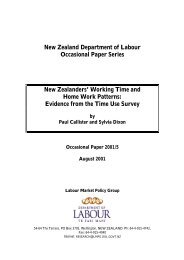

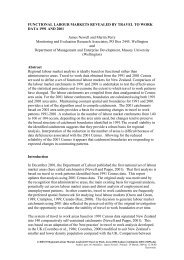
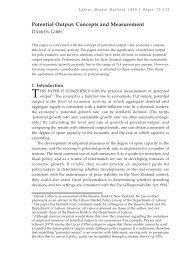

![a note on levels, trends, and some implications [pdf 21 pages, 139KB]](https://img.yumpu.com/27285836/1/184x260/a-note-on-levels-trends-and-some-implications-pdf-21-pages-139kb.jpg?quality=85)


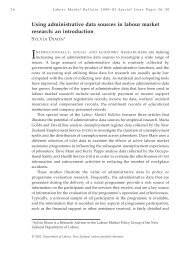
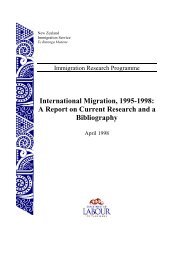
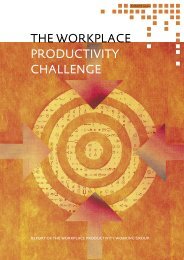
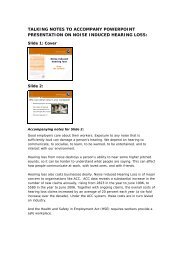
![Labour Market Trends and Outlook - 1996 [pdf 18 pages, 94KB]](https://img.yumpu.com/27285764/1/184x260/labour-market-trends-and-outlook-1996-pdf-18-pages-94kb.jpg?quality=85)

